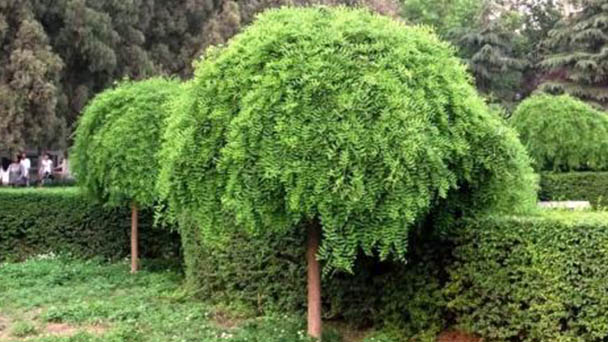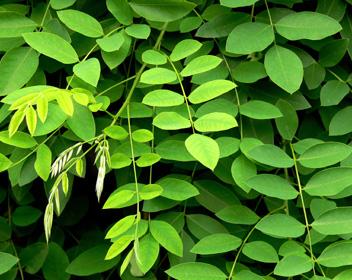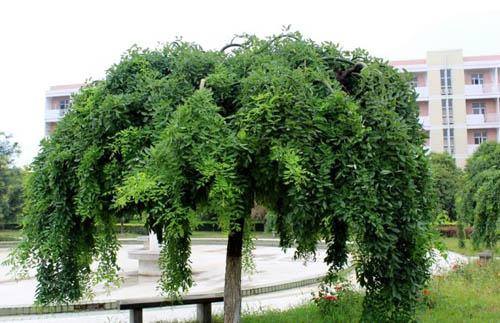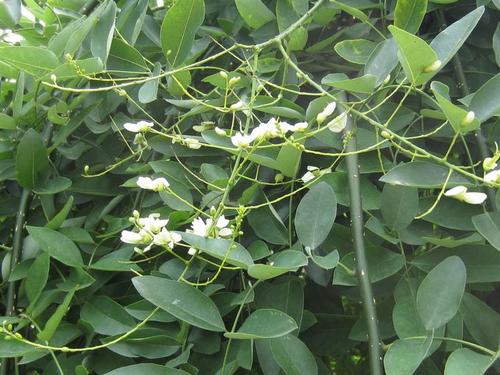Japanese Pagoda (Styphnolobium Japonicum) Profile
Written by Maggie
Nov 01 2021

Japanese Pagoda (scientific name: Styphnolobium japonicum) is a tree with a height of 25 m. The bark is grayish-brown, longitudinally cracked. Current shoots are green, glabrous.
Japanese Pagoda is a sprout variant of the Japanese Pagoda. It is a deciduous tree, light-loving, slightly shade-tolerant and can adapt to the cold and dry climate. Japanese Pagoda has a beautiful crown, fragrant flowers, is a street tree and excellent nectar source plants; Flower and pod into medicine, cool and astringent, hemostasis antihypertensive effect; Leaves and root skin have the effect of clearing heat and detoxifying, can treat sore poison; Wood is used for construction. Due to different habitats or the result of artificial breeding, the species has a variety of morphologies and variants.
Japanese Pagoda Picture

Characteristics of Japanese Pagoda
Pinnately compound leaves of Japanese Pagoda are up to 25 cm long; Leaf axis initially pubescent, soon declosed; Petiole base enlarged, enveloping buds; Stipules vary in shape, sometimes ovate, foliate, sometimes linear or subulate, caducous; Leaflets 4 to 7 pairs, opposite or subalternate, paperious, ovate-lanceolate or ovate-oblong, 2.5 to 6 cm long and 1.5 to 3 cm wide, apex acuminate, apically apiculate, base broadly cuneate or suborbicular, slightly oblique, underside grayish-white, sparsely pubescent at first, spirally glabrous; Japanese Pagoda has 3 stipules, subulate.
Panicles of Japanese Pagoda are terminal, often pyramidal, up to 30 cm long; Pedicels shorter than calyx; Japanese Pagoda has 2 bracteoles, shaped like stipules; Calyx shallowly campanulate, ca. 4 mm long, calyx teeth 5, subequal, rounded or obtuse triangular, gray-white pubescent, calyx tube subglabrous; Corolla of Japanese Pagoda is a white or pale yellow, flag suborbicular, ca. 11 mm long and wide, shortly stipitate, with purple veins, apex emarginate, base shallow-heart-shaped, apex rounded, base oblique halbert, without wrinkle, keel broadly ovate-oblong, as long as the lobe, up to 6 mm wide; Stamens of Japanese Pagoda are subseparate, persistent; Ovary subglabrous.
Pods of Japanese Pagoda are beadlike, 2.5 -- 5 cm long or slightly long, about 10 mm in diameter, not obvious puckered between seeds, closely arranged seeds, fleshy pericarp, not dehiscing after maturity, with 1 -- 6 seeds; Seeds of Japanese Pagoda are ovoid, yellowish-green, dark brown after drying.
Habits of Japanese Pagoda
Japanese Pagoda is light-loving, slightly shade tolerant. Japanese Pagoda can adapt to the cold and dry climate.Lovely in the deep soil layer, moist and fertile, good drainage sandy loam. Japanese Pagoda has deep roots, a developed root system, strong wind resistance, strong germination, long life. It has a certain resistance to sulfur dioxide, hydrogen fluoride, chlorine and other poisonous gases and smoke.
Distribution of Japanese Pagoda
Japanese Pagoda plant is originally produced in China, now the north and south provinces and regions are widely cultivated, especially in North China and the Loess Plateau region. Fushun, tiling, Shenyang and its southern areas have been introduced planting, Guangzhou north of all cultivation, and to the south of the Yangtze River area more. Hebei, Beijing, Shandong and Jiangsu Shuyang can be found everywhere.
Japanese Pagoda was introduced to Japan in the Song Dynasty, and then to Europe in the mid-18th century, and then to America from Europe. Japan, Vietnam also have distribution, Korea and see a wild, Europe, the Americas have introduced.
Propagation of Japanese Pagoda
After falling leaves in autumn every year, cut the strong new branches and cut Japanese Pagoda into small sections of about 15cm. Bind them into bundles and soak them in water for 30 hours so that they can absorb enough water. Then the strong rooting agent water with a concentration of 100 times than dilution, and then add clay into a paste, coated with cuttings root, cuttings immediately to the greenhouse seedling sand bed, the temperature is maintained at about 30℃. Humidity is maintained at around 80%. When the root buds appear. It is advisable to transplant Japanese Pagoda to the greenhouse in time, and the spacing between plants is 15cmx25cm. Small seedlings out of about 10cm water 1 times, for foliar fertilizer spray. Promote seedling growth. When the outside average temperature is at 20℃, the greenhouse film is gradually uncovered (avoid once to remove the film, in case of exposure to the seedlings), which can be shaded with a shading net for one to two weeks, in case of dead seedlings.
Japanese Pagoda Propagation from grafting
In spring, select seedlings of Japanese Pagoda with a diameter above 5 cm at breast height in the nursery to stay 1.5~2.5m fixed dry. When the new branch is about 10cm long, 6~8 branches with uniform distribution in different directions should be selected. The rest is erased from the base. The best height of these branches in the trunk should be concentrated in the 10cm range. If the number of branches is insufficient or the distribution is not uniform, the adjacent vacant branches can be repacked by 5cm to meet the requirements. A
The grafting took place in spring. Choose the outer branches of a beautiful, insect-free Japanese Pagoda line tree. The collection of branches can be combined with the pruning of the mother tree. Sleeping buds are better. In spring, dormant buds are taken from the previous one-year shoots of Japanese Pagoda as scions and grafted on the 1-2 year new shoots of Japanese Pagoda. In addition, the new buds of the same year can also be grafted in early summer.
Grafting is best in late spring, and the later grafting occurs, the higher the survival rate. Avoid rain, or the scion will rot. The bud plate is grafted. First, a knife is cut into the smooth part on the back of the base of the rootstock branch, 5~15cm away from the base. The knife is gradually cut upward to reach the xylem, and finally, the elliptical joint is cut, the length of which is about 2~3cm. In the middle of the scion, the lower part of the full bud was cut with a knife about 1cm, and gradually the upper part was cut, reaching to the xylem, and the elliptical bud plate was cut about 1cm above the bud. The length and width of the bud are slightly smaller than that of the rootstock interface. Place the bud on the rootstock and align the four sides. If the bud is small, one side of the bud can match the cut face of the rootstock. Then wrap it up with the plastic film.
Japanese Pagoda Propagation from Cutting
Cut off half of the branch of Japanese Pagoda immediately. Leave a new branch at the front of each branch and scour the rest. About 20 days after grafting, cut the anvil 1cm in front of grafting the bud, and often erase the redundant bud. According to the growth of the tree, in the sag of the branches to pick the heart, promote the number of branches. Usually the heart is picked twice. In summer, top dressing twice, mainly with nitrogen fertilizer, and combined with top dressing watering. Prompt prevention and control of pests and weeds.

Disease Control of Japanese Pagoda
Root rot of Japanese Pagoda, also known as rotting disease, affects the seedlings, saplings and trees of Japanese Pagoda. Often causes twigs to wither or seedlings to die.
Symptoms: First, Fusarium disease, which affects the green trunk of 2-4 years old seedlings and the green twigs of large trees, mainly occurs at the cutting mouth or necrotic skin hole. The disease spots are light yellowish-brown and nearly round at the beginning, and then expand into fusiform or circular stem with a length of 1~5cm, yellowish-brown wet rot, slightly sunken, and smell of wine's grains. In the future, the red conidia pile grows on the disease spot. If the disease spot does not ring cut the trunk, the disease department can heal in that year, and there is no recurrence later. Individual spots such as healing in the year are not good, the next year from the old spots spread around. The second is the small hole shell fungus type rotting disease, the initial symptoms are similar to the previous one, but the color of the disease spot is slightly lighter, and there is a purplish brown edge, the length can reach more than 20cm, and can ring cut the trunk, the late disease spot grows many small black spots, that is, the conidia of the pathogen. The late stage of the disease is gradually dry up and become become become become become become become become become become become become become become become become more or less, but the disease spot is around rarely produced healing tissue, so the next year still has the recurrence phenomenon.
Prevention and control measures: 1. When transplanting large seedlings, avoid excessive root and pruning, and should be promptly watered and preserved to enhance their disease resistance. 2 during the spring and autumn, the seedling dry and fine trees green and snip, TuHanEr pulpy or sulfur coated white, prevent germs dye. 3, timely cut off the disease dead branches, focus on burning, reduce the source of pathogen infection.4, floating dust in serious areas, should be the timely treatment of insects, reduce harm. The road trees with a serious disease can be sprayed with 40% ethylphosphor aluminum and 40% carbendazim suspension 200~300 times liquid.
Edge leaf disease is also called leaf coke disease. Caused by two reasons: 1, a bacterial disease, mostly from the lateral leaf or heartleaf edge began to occur, along the leaf edge to the petiole direction yellowing, leaf edge produced brown necrosis plaque, with the development of the disease leaf edge withered, leaf color pale, finally all wilting die. In the case of more water loss in the leaf, the pathogen infects from the leaf margin, causing pathological changes and necrosis of parasitic leaf tissue, and gradually spreading. The pathogen overwintered with the seed or the residual body, and the suitable temperature was 28~32℃.2. Calcium malnutrition is also a symptom of this disease. Calcium in plants can form insoluble calcium salts and settle down, which is an element that cannot be reused. Therefore, calcium deficiency is often present in newborn tissues. After the occurrence of leaf coke disease, lateral leaf or heartleaf edge produced brown spots, serious ring death, dry.
Prevention and control methods :(1) the planting temperature should be appropriate, avoid too high or too low. (2) Protect the root system function normally, the relative humidity should not be too high for a long time, and try to keep the humidity normal. (3) Spraying Hui Manfeng, promoting Fengbao and ensuring bumper harvest and other foliar fertilizer has certain effects. (4) there are bacteria infection, can spray the prevention and control of bacterial diseases, such as Jiarinong (47% Chunlei Wang copper wet powder) 1000 times the liquid, LvDeBao, copper noble (30% basic copper sulfate suspension agent) 400 times the liquid, can kill (53.8% copper hydroxide dry suspension agent) 500 times liquid, etc.
Japanese Pagoda Uses
Beautiful crown, fragrant flowers, Japanese Pagoda is a street tree and excellent nectar source plants; Wood is used for construction. Due to different habitats or the result of artificial breeding, the species has a variety of morphologies and variants.
Japanese Pagoda is an excellent garden tree with graceful posture. Japanese Pagoda is suitable for solitary planting, planting, planting. Japanese Pagoda has a long life, strong adaptability, less strict requirements on soil, better barren tolerance, and high ornamental value. Therefore, landscape soil is widely used and is often used as dooryard and roadside trees. Or a court shade tree; Or placed in the lawn as ornamental trees. During the festival, if the tree is equipped with colorful lights, it is more magnificent. I use short dry potted ornamental, make a person feel soft and natural. Flowering season, the beige inflorescence is full of branches, be like a yellow umbrella to cover the eye, it is more beautiful and lovely.
How to Grow and Care for Japanse Pagoda
Latest Updated
- Benefits of Bugleweed - 7 Science-backed Health Benefits
- Bugleweed Dangers & Side Effects - Is It Poisonous?
- How to Plant Evergreen Trees - What You Should Know
- When to Plant Evergreens - Grow Guide for Evergreen Trees
- 12 Wonderful Evergreen Shrubs for Your Garden
- 12 Popular Evergreen Plants with Pictures for Beginners
- When And How To Prune A Lilac Bush Like a Pro
- How to Grow & Care for Lilac Vine (Hardenbergia Violacea)
- Japanese Lilac Tree (Syringa Reticulata) Care & Propagation Guide
- Shumard Oak Pros and Cons - What to Know
Popular Articles
- Winter maintenance of Antirrhinum Majus
- How to Grow Terminalia Mantaly Tree
- How to Grow and Care for Crossostephium Chinense
- How to grow Antirrhinum Majus in spring
- Peristeria Elata (Dove Orchid) Profile: Info & Care Guide
- Underwatered Snake Plant (Sansevieria Trifasciata) - Signs And How To Fix
- How to Care for Brazilian Jasmine Plant (Mandevilla Sanderi)
- How to Grow & Care for Graptopetalum Purple Delight in Summer
- Rosa Chinensis (China Rose): Plant Growing & Care Tips
- How to Care for Baby Sun Rose (Aptenia Cordifolia)